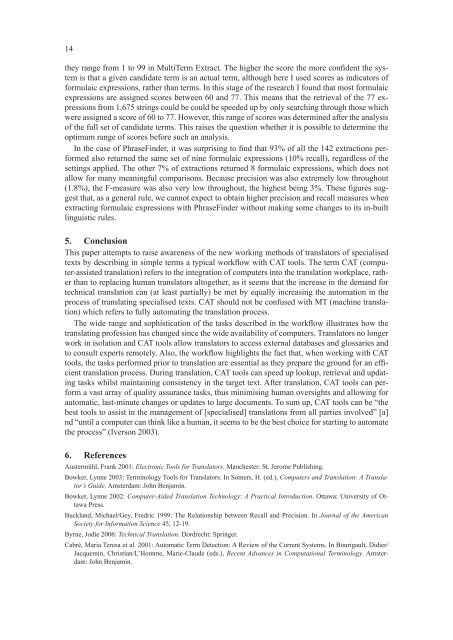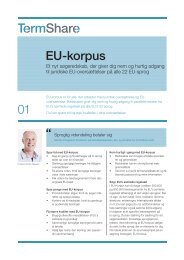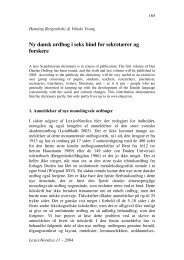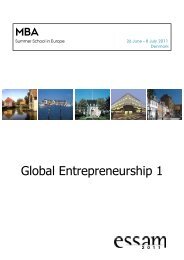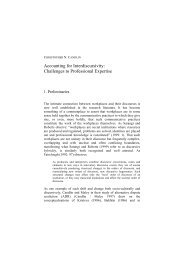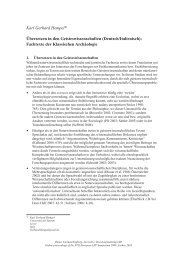The Workflow of Computer-Assisted Translation Tools in
The Workflow of Computer-Assisted Translation Tools in
The Workflow of Computer-Assisted Translation Tools in
You also want an ePaper? Increase the reach of your titles
YUMPU automatically turns print PDFs into web optimized ePapers that Google loves.
14<br />
they range from 1 to 99 <strong>in</strong> MultiTerm Extract. <strong>The</strong> higher the score the more confi dent the system<br />
is that a given candidate term is an actual term, although here I used scores as <strong>in</strong>dicators <strong>of</strong><br />
formulaic expressions, rather than terms. In this stage <strong>of</strong> the research I found that most formulaic<br />
expressions are assigned scores between 60 and 77. This means that the retrieval <strong>of</strong> the 77 expressions<br />
from 1,675 str<strong>in</strong>gs could be could be speeded up by only search<strong>in</strong>g through those which<br />
were assigned a score <strong>of</strong> 60 to 77. However, this range <strong>of</strong> scores was determ<strong>in</strong>ed after the analysis<br />
<strong>of</strong> the full set <strong>of</strong> candidate terms. This raises the question whether it is possible to determ<strong>in</strong>e the<br />
optimum range <strong>of</strong> scores before such an analysis.<br />
In the case <strong>of</strong> PhraseF<strong>in</strong>der, it was surpris<strong>in</strong>g to fi nd that 93% <strong>of</strong> all the 142 extractions performed<br />
also returned the same set <strong>of</strong> n<strong>in</strong>e formulaic expressions (10% recall), regardless <strong>of</strong> the<br />
sett<strong>in</strong>gs applied. <strong>The</strong> other 7% <strong>of</strong> extractions returned 8 formulaic expressions, which does not<br />
allow for many mean<strong>in</strong>gful comparisons. Because precision was also extremely low throughout<br />
(1.8%), the F-measure was also very low throughout, the highest be<strong>in</strong>g 3%. <strong>The</strong>se fi gures suggest<br />
that, as a general rule, we cannot expect to obta<strong>in</strong> higher precision and recall measures when<br />
extract<strong>in</strong>g formulaic expressions with PhraseF<strong>in</strong>der without mak<strong>in</strong>g some changes to its <strong>in</strong>-built<br />
l<strong>in</strong>guistic rules.<br />
5. Conclusion<br />
This paper attempts to raise awareness <strong>of</strong> the new work<strong>in</strong>g methods <strong>of</strong> translators <strong>of</strong> specialised<br />
texts by describ<strong>in</strong>g <strong>in</strong> simple terms a typical workfl ow with CAT tools. <strong>The</strong> term CAT (computer-assisted<br />
translation) refers to the <strong>in</strong>tegration <strong>of</strong> computers <strong>in</strong>to the translation workplace, rather<br />
than to replac<strong>in</strong>g human translators altogether, as it seems that the <strong>in</strong>crease <strong>in</strong> the demand for<br />
technical translation can (at least partially) be met by equally <strong>in</strong>creas<strong>in</strong>g the automation <strong>in</strong> the<br />
process <strong>of</strong> translat<strong>in</strong>g specialised texts. CAT should not be confused with MT (mach<strong>in</strong>e translation)<br />
which refers to fully automat<strong>in</strong>g the translation process.<br />
<strong>The</strong> wide range and sophistication <strong>of</strong> the tasks described <strong>in</strong> the workfl ow illustrates how the<br />
translat<strong>in</strong>g pr<strong>of</strong>ession has changed s<strong>in</strong>ce the wide availability <strong>of</strong> computers. Translators no longer<br />
work <strong>in</strong> isolation and CAT tools allow translators to access external databases and glossaries and<br />
to consult experts remotely. Also, the workfl ow highlights the fact that, when work<strong>in</strong>g with CAT<br />
tools, the tasks performed prior to translation are essential as they prepare the ground for an effi -<br />
cient translation process. Dur<strong>in</strong>g translation, CAT tools can speed up lookup, retrieval and updat<strong>in</strong>g<br />
tasks whilst ma<strong>in</strong>ta<strong>in</strong><strong>in</strong>g consistency <strong>in</strong> the target text. After translation, CAT tools can perform<br />
a vast array <strong>of</strong> quality assurance tasks, thus m<strong>in</strong>imis<strong>in</strong>g human oversights and allow<strong>in</strong>g for<br />
automatic, last-m<strong>in</strong>ute changes or updates to large documents. To sum up, CAT tools can be “the<br />
best tools to assist <strong>in</strong> the management <strong>of</strong> [specialised] translations from all parties <strong>in</strong>volved” [a]<br />
nd “until a computer can th<strong>in</strong>k like a human, it seems to be the best choice for start<strong>in</strong>g to automate<br />
the process” (Iverson 2003).<br />
6. References<br />
Austermühl, Frank 2001: Electronic <strong>Tools</strong> for Translators. Manchester: St. Jerome Publish<strong>in</strong>g.<br />
Bowker, Lynne 2003: Term<strong>in</strong>ology <strong>Tools</strong> for Translators. In Somers, H. (ed.), <strong>Computer</strong>s and <strong>Translation</strong>: A Translator’s<br />
Guide. Amsterdam: John Benjam<strong>in</strong>.<br />
Bowker, Lynne 2002: <strong>Computer</strong>-Aided <strong>Translation</strong> Technology: A Practical Introduction. Ottawa: University <strong>of</strong> Ottawa<br />
Press.<br />
Buckland, Michael/Gey, Fredric 1999: <strong>The</strong> Relationship between Recall and Precision. In Journal <strong>of</strong> the American<br />
Society for Information Science 45, 12-19.<br />
Byrne, Jodie 2006: Technical <strong>Translation</strong>. Dordrecht: Spr<strong>in</strong>ger.<br />
Cabré, Maria Teresa et al. 2001: Automatic Term Detection: A Review <strong>of</strong> the Current Systems. In Bourigault, Didier/<br />
Jacquem<strong>in</strong>, Christian/L’Homme, Marie-Claude (eds.), Recent Advances <strong>in</strong> Computational Term<strong>in</strong>ology. Amsterdam:<br />
John Benjam<strong>in</strong>.


